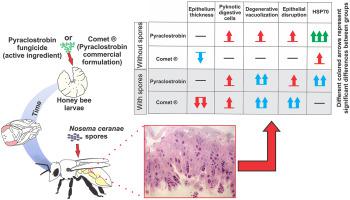Environmental Pollution ( IF 7.6 ) Pub Date : 2020-09-18 , DOI: 10.1016/j.envpol.2020.115622 Rafaela Tadei , Vanessa B. Menezes-Oliveira , Elaine C.M. Silva-Zacarin

|
The frequent exposure of bees to a wide variety of fungicides, on crops where they forage, can be considered a stressor factor for these pollinators. The organisms are exposed both to the fungicide active ingredients and to the adjuvants of commercial formulations. All these ingredients are brought to the hive by bee foragers through contaminated pollen and nectar, thus exposing also immature individuals during larval phase. This work aimed to compare the effects of larval exposure to the fungicide pyraclostrobin (active ingredient and commercial formulation) and its influence on the cytotoxicity to midguts in adults, which were inoculated with the Nosema ceranae spores in the post-emergence stage. Under laboratory conditions, Apis mellifera larvae received an artificial diet containing fungicide solution from the third to the sixth day of the feeding phase. One-day-old adult workers ingested 100,000 infectious N. ceranae spores mixed in sucrose solution. Effects on midgut were evaluated through cellular biomarkers of stress and cell death. The exposure to the fungicide (active ingredient and commercial formulation) did not affect the larval post-embryonic development and survival of adult bees. However, this exposure induced cytotoxicity in the cells of the midgut, showed by the increase in DNA fragmentation and alteration in the HSP70 immunolabeling pattern. Without the pathogen, the midgut cytotoxic effects and HSP70 immunolabeling of the organisms exposed to the commercial formulation were lower when compared to the exposure to its active ingredient. However, in the presence of the pathogen, the cytotoxic effects of the commercial formulation to the adult bees’ midgut were potentialized. The pathogen N. ceranae increased the damage to the intestinal epithelium of adult bees. Thus, realistic doses of pyraclostrobin present in beebread consumed by larvae can affect the health and induce physiological implications to the midgut functions of the adult bees.
中文翻译:

杀菌剂吡菌酯对成年非洲非目标生物蜜蜂的幼虫暴露及其与病原体Nosema ceranae相互作用的沉默作用
蜜蜂在觅食的农作物上经常暴露于各种杀菌剂中,可以认为是这些授粉媒介的压力因素。该生物既暴露于杀真菌剂活性成分,也暴露于商业制剂的佐剂。蜜蜂觅食者通过受污染的花粉和花蜜将所有这些成分带入蜂巢,从而在幼虫期也暴露了未成熟个体。这项工作旨在比较幼虫暴露于杀菌剂吡菌酯(活性成分和市售制剂)的影响及其对成年中肠的细胞毒性的影响,这些成虫在萌发后阶段接种了蜡状鼻头孢子。在实验室条件下,蜜蜂在喂养阶段的第三天到第六天,幼虫接受了含有杀菌剂溶液的人工饮食。1天大的成年工人摄入了100,000株传染性ceranae ceranae孢子混合在蔗糖溶液中。通过应激和细胞死亡的细胞生物标志物评估对中肠的影响。暴露于杀真菌剂(活性成分和商业配方)不会影响成年蜜蜂幼虫的胚后发育和存活。然而,这种暴露在中肠细胞中诱导了细胞毒性,这表现为DNA片段的增加和HSP70免疫标记模式的改变。没有病原体,与暴露于其活性成分相比,暴露于商品制剂的生物体的中肠细胞毒性作用和HSP70免疫标记要低。然而,在病原体的存在下,商业制剂对成年蜜蜂中肠的细胞毒性作用被潜在化。病原体N. ceranae增加了对成年蜜蜂肠道上皮的损害。因此,幼虫食用的面包中存在的吡咯菌酯的实际剂量可以影响成年蜜蜂的健康并诱导其对中肠功能的生理影响。











































 京公网安备 11010802027423号
京公网安备 11010802027423号